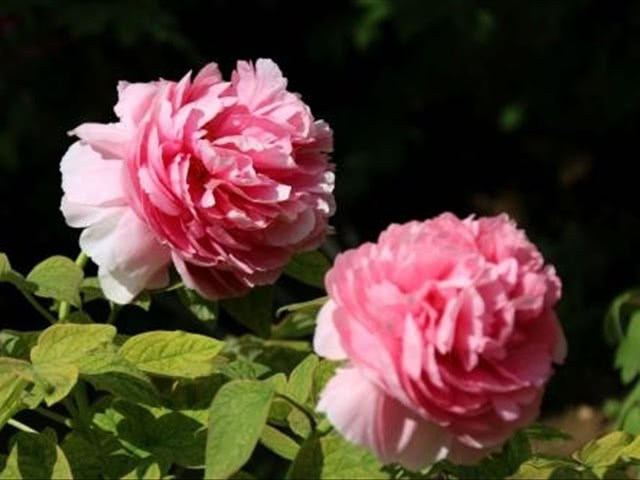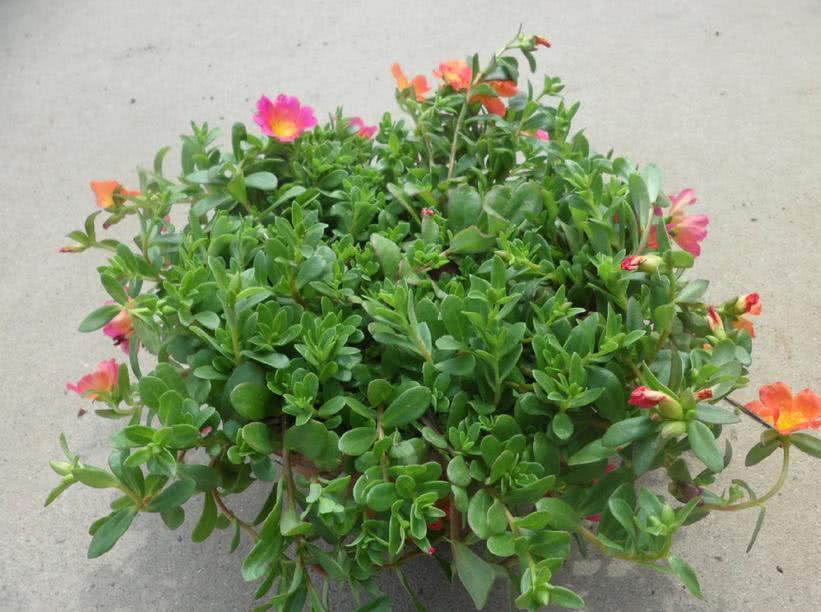If you see this kind of flower blooming and don't go home for dinner, you should be scolded by your mother.

Purple jasmine is really a kind of kind of plant. As the most widely cultivated domestic grass flower in China, even if you don't know its name, you may have seen it since childhood. However, like sunflowers, red flowers, morning glory and other common flowers, purple jasmine is not a native plant, but comes from as far away as Latin America.
Purple jasmine is also a flower I have planted since I was a child. At that time, I didn't know its name. I only knew that adults called it pink bean flower or minefield flower. It was not until I saw it in my high school biology textbook many years later that I suddenly realized that I was an old friend I had known for a long time.
Purple jasmine, could it be an old friend of yours, too? Picture: Khalid Mahmood / wikimedia
How many names
Purple jasmine belongs to the family Nyctaginaceae, which is a sister of the same family as the common leaf flower (triangular plum) in South China. The genus Mirabilis, in which it is located, consists of about 50 species, centering on tropical South America. As one of the most common species of this genus, purple jasmine was cultivated and used as a medicinal plant by indigenous people a long time ago.
The first botanist to describe Mirabilis was Carl Von Linne, who officially published it in Species Plantarum in 1753, using Mirabilis jalapa as its scientific name. Linnai mentioned in the article that there are many unusual changes in the color of purple jasmine, so he gave it the generic name Mirabilis, which means "wonderful".
Even on the same plant, various colors of purple jasmine can be seen. Picture: Vaikoovery / wikimedia
At present, there are two ways to explain the kind of additive jalapa. One theory is that the origin of purple jasmine may come from the Jalapa region of Guatemala.
Another explanation may have to do with the city of Xalapa in Mexico, where a laxative called jalap was once produced, so the place name can also be written as Jalapa. The laxative was extracted from the tuber of Ipomoea purga (temporarily named "laxative sweet potato" in Chinese and tuberous jalap in English), whose flowers happen to resemble purple jasmine. Botanists often refer to the names of known similar plants when naming new plants, and this explanation seems quite reasonable.
Meimei's Ipomoea purga can be used as a laxative. Picture: Michael Kesl / biolib.cz
After it was introduced into our country, purple jasmine has been widely planted in the north and south of the Yangtze River, and people all over the country have given it all kinds of common names, such as dinner flower, bath flower, night Jiaojiao, wild jasmine, wild clove, henna, rouge, minefield, pink bean flower and so on.
In fact, these common names precisely reflect the habits of purple jasmine: for example, it is a flower blooming in the evening, mainly blooming at night; the flower is fragrant, and the fragrance is similar to jasmine; petals can be used to dye nails or rouge, and so on.
Purple jasmine also has two common English names-the marvel of Peru (Peruvian miracle) and four o "clock flower (04:00 flower). The former name is the same as the scientific name given by teacher Linnai, and the latter coincides with the Chinese common name. seeing this flower means it's getting dark, which is the time for your mother to call you home for dinner or shower.
02:45?! Picture: Salvatore Ingala / wikimedia
It's a girl's earring and a boy's mine.
In temperate regions, purple jasmine is usually an herb no more than 1 meter tall, withering and dying every winter, and a new generation will grow next year.
In fact, purple jasmine, which is native to tropical America, is a perennial plant that can grow for many years. Its underground rhizome is thick and can store nutrients. It can also grow up to 1 to 2 meters high, with dense branches and vigorous growth. It looks like a small shrub.
The root of purple jasmine will be dried by illegal traders to pretend to be Gastrodia elata or ginseng, but it contains toxins such as trigonelline, which can make people vomit and diarrhea. Picture: VisionsPictures / mindenpictures
Purple jasmine flowers are also quite unusual, looking like petunias slimming behind, but there is still a difference between the two. The Corolla of Petunia is healed by five petals, and there are five green sepals at the base, and the Corolla and calyx are clearly distinguished; although the flowers of Mirabilis are also similar deep funnel-shaped, the base also has a 5-lobed green calyx-like structure, but it is not a real calyx, but a calyx-like involucre.
Calendar Niangji expansion time
Calyx and petals (Corolla, to be exact) are collectively referred to as perianth, which are necessary to form a complete flower (including pedicel, receptacle, stamen and gynoecium). The involucre is specialized from the leaves near the inflorescence, which is completely different from the calyx in origin.
The colorful part of purple jasmine has only one layer, there is no way to distinguish calyx from petals, we can only call it perianth, this single-layer perianth flower is not a complete flower, so purple jasmine is also called single perianth flower. Many members of Ranunculaceae introduced before the species calendar are also monotepous (such as Pulsatilla, anemone, Acer clematis, Swertia Asarum, etc.).
Petunia (left) and purple jasmine (right). Picture: Fanghong & KENPEI / wikimedia
Purple jasmine, which blooms at night, will certainly miss daytime insects, but it also has a trick to attract nocturnal moths to pollinate by emitting a strong scent of flowers.
Purple jasmine flowers are relatively narrow deep cylinder-shaped, and only the long-beaked diamondback moth has the ability to absorb its nectar. After the purple jasmine is in full bloom, both the female and stamen will stick out of the perianth tube to rub the pollen on the visiting diamondback moth or remove the pollen from the visiting diamondback moth.
Japanese diamondback moth (Theretra japonica) shuttles among purple jasmine. Picture: Satoshi Kuribayashi / mindenpictures
The post-80s who grew up in rural areas must have bullied Mirabilis when they were young. Girls who love beauty will pick the flowers of purple jasmine and dye their nails, or pull off the flowers and carefully let the perianth tube slide through the pistil style, and the inflated stigma can be stuck at the base of the tube, so that the whole flower can be suspended through the style, and then the basal globular ovary is stuffed into the ear to make a Mori earring.
Naughty boys mainly pick its fruit for use as bullets. When the purple jasmine fruit is ripe, the dark peel will become hard, and the lines on the surface make it look like a miniature version of a landmine. It hurts a bit to hit people with self-made small projectiles, but it won't get hurt, so it becomes a sharp weapon for chasing and playing (bullying classmates).
Have you ever played with this kind of landmine? Picture: Doctoroftcm / wikmedia
From experimental subjects to invasive plants
The story I remember most about Mirabilis is the scientific experiment using it as material in the biology textbook of high school.
Around 1900, the German botanist Carl Correns discovered the purple jasmine mutant with albino and flower spots on its leaves, and then carried out a hybrid experiment, but found that the leaf color of the hybrid progeny only depended on the traits of the female parent and had nothing to do with the male parent who provided pollen. He speculated that some factors outside the nucleus must have affected the post-representative type, so that the experimental results did not conform to Mendelian law of gene separation and free combination.
Although it has no effect on the leaf characters of the offspring, we should still know what the purple jasmine pollen looks like under the electron microscope. Picture: Albert Lleal / mindenpictures
Later, further studies confirmed that the gene that controls the leaf color of purple jasmine is located in the chloroplast in the cytoplasm. When sperm and eggs combine, only the nucleus and egg cells fuse, so the chloroplast gene in the egg cell becomes the decisive factor to control the leaf color of offspring. This has also become a classic case of cytoplasmic inheritance in botany.
In addition to this famous leaf color genetic experiment, the flower color change of purple jasmine is also full of surprises. The color of purple jasmine can be described as varied, in addition to the common purple red, white and yellow, there are mosaic color, stripe color and sprinkling color, sometimes even the same plant or even the same branch, it is possible to produce flowers of different colors.
Studies have shown that the heredity of flower color of purple jasmine is not completely dominant. For example, when pure red flowers (AA) are crossed with pure white flowers (aa), pink or mosaic offspring (Aa) will be produced instead of pure red. In this case, red and white genes have the same power, and neither of them can completely dominate the other.
Purple jasmine of different colors. Picture: KENPEI & Wildfeuer & LucaLuca & Steve Sanders / wikmedia
It should be noted that purple jasmine is a self-propagating species that grows rapidly in tropical areas with plenty of sunshine, warm climate and plenty of water. If left uncontrolled, it will escape from the garden to the wild and become a naturalized plant.
At present, purple jasmine has spread in Asia, Africa, North America, Europe and other places, and even grown in some tropical islands and warm and humid coastal areas, becoming a dominant invasive plant, seriously affecting the growth of local plants.
This article is the 247th article in the fourth year of the species calendar, from the author of the species calendar @ Banna Hualun.
Wonderful content that you may miss
Calendar Niang today's avatar
Purple jasmine family Huang careful
- Prev

Can the peony flowers of national color and Tianxiang be raised in the bedroom? Indoor maintenance method is simple
Original title: can peony flowers of national color and Tianxiang be raised in the bedroom? Indoor maintenance method is simple! Abstract: many of us are raising flowers, but we don't know if flowers can be put in the bedroom. In fact, there are many flowers.
- Next

Sunflower grafted Portulaca oleracea in autumn is more beautiful than peony.
Now everyone likes some flowers and plants in life. Among these flowers, sunflower is a more common plant. A lot of florists have planted this. It is a perennial herb, this plant vitality is very strong, adapt.
Related
- Wuhan Hospital Iron Tree Blooming Result Was Instantly Frightened by the Gardener Master
- Which variety of camellia is the most fragrant and best? Which one do you like best?
- What is the small blue coat, the breeding methods and matters needing attention of the succulent plant
- Dormancy time and maintenance management of succulent plants during dormancy
- Minas succulent how to raise, Minas succulent plant pictures
- What are the varieties of winter succulent plants
- How to raise succulent plants in twelve rolls? let's take a look at some experience of breeding twelve rolls.
- Attention should be paid to water control for succulent plants during dormant period (winter and summer)
- Watering experience of twelve rolls of succulent plants
- Techniques for fertilizing succulent plants. An article will let you know how to fertilize succulent plants.

